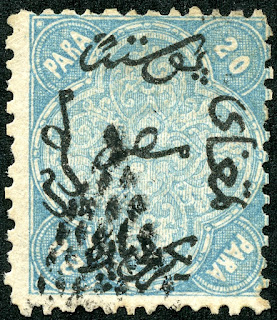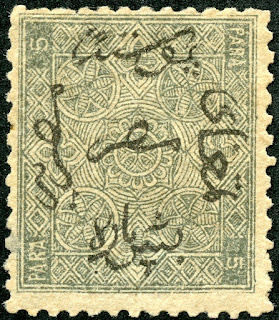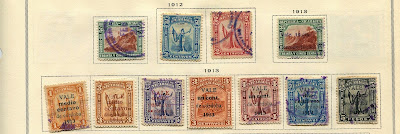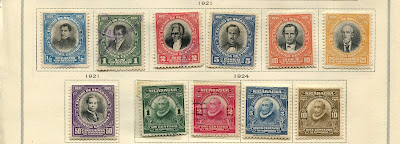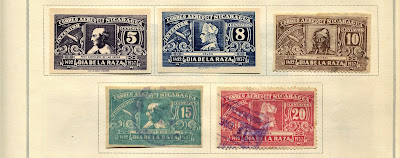Arms of Nicaragua (United Provinces
of Central America), 1823-25
Bud's Observations
Nicaragua’s stamps fill more pages in my Big Blue than
those of any other country – 19 original album pages and 22 supplement pages.
Why? Overprints and double overprints, anomalies (inversions, color shades,
imperfs, misperfs, fold-overs), trial proofs, official stamps, unofficial
officials, and split currency areas (silver in the east, paper money in the
west). Add to these the irrelevant and unusable stamp values produced by
Nicolas Seebeck, Nicaragua’s favored printer in the late 19th
century. Nicaragua album pages fill quickly with many redundant mint images.
This excess, however, is not without attractiveness
and historical interest. Take, for instance, the frequent appearance of the
liberty cap, el gorro frigio, sometimes hoisted on a pike atop a
mountain and sometimes floating mid-air.
El
gorro frigio
The roughly conical cap with a floppy top originated
in ancient Phrygia. It was adopted during 18th century American revolution as a
symbol for freedom from colonial oppression, although the ancient cap had
nothing to do with freedom. Nevertheless, Nicaragua follow suit.
Scott #s 1 dark blue, 54 slate, 103
violet, 305 green and chestnut, o128 carmine
(Remember to click on an image to enlarge it)
On stamps, the cap hovers over the five volcanic
mountains that represent the five Central American countries -- Costa Rica, El
Salvador, Guatemala, Honduras, and Nicaragua. Usually the cap is very small, as
on Scott #o128, and easily mistaken for a crucifix or overlooked altogether.
Scott# 54, cap magnified
Beyond the USA and Nicaragua, many countries in
Central and South America have adorned stamps and coins with Phrygian caps,
including Mexico and Argentina.
Liberty with a Phrygian cap on a
pike, USA one cent, 1795
Scott #305 has a close
resemblance to the Nicaragua coat of arms – a triangle showing a free floating,
glorified cap, as well as the water of two oceans, perhaps a hope-inspired
rainbow, and the five mountains. A second cap can be seen below the triangle in
an image similar to Scott #54.
A particularly
interesting and treacherous area of Nicaraguan philately is the local stamps of
Cabo Gracias a Dios and Bluefields. These are mostly regular Nicaragua stamps
overprinted for use in the eastern part of the country where currency was
denominated in silver; they’re treacherous because the double and sometimes
triple overprints are expensive and easily faked (Scott’s catalog says so).
Scott #s 2L50 violet, 2L1 plum,
2L16 plum, unlisted yellow, 2L31 slate
Cabo Gracias a Dios is
thought to have been named by Christopher Columbus in 1502 in thanksgiving for
deliverance from rough seas, perhaps a hurricane. The above scan shows four
hand-stamped Cabo overprints, the most impressive being the yellow one peso
with a clear Cabo cancellation. Sadly, Scott doesn’t list it as a legitimate
stamp. So, I tend to regard it as a fancy flimflam. But then, there are hundreds
of unlisted and unauthorized hand-stamped surcharges.
Bluefields, located south
of Cabo on the Atlantic coast, derives its name from Abraham Blauvelt, a Dutch
pirate in the early 17th century. The stamps commonly have two
overprints, a capital “B” for Bluefields and “Dpto Zelaya” for the Province of
Zelaya, the latter overprint being the smaller. Inking and clarity vary
greatly.
Scott #s 1L22 carmine rose, 1L2
vermilion, 1L3 green, 1L13 violet, 1L67 blue and black
Largely isolated from the
rest of the country, Bluefields was only recently connected by a highway to the
western part of Nicaragua. Railways in eastern Nicaragua were a political dream
(although a philatelic reality). Ferrocarril de Nicaragua never delivered mail
(or anything else) to Bluefields or Cabo.
Hence the double irony of
Scott #s 1L109-1L123: locomotives are featured on the one series of stamps
issued specifically for purchase with the silver coins of eastern Nicaragua, a
place without trains. Moreover, in 1912, the year after this series was issued,
Ferrocarril de Nicaragua changed its name to Ferrocarril del Pacifico de
Nicaragua. A gesture of honesty, I suppose. The last effort to extend rail
service to the Atlantic succumbed in 1909, never to be revived.
Scott
#s 1L111 orange brown, 1L119 brown and black, and 1L120 olive green
The philatelic locomotive
is generic, not a likeness of Nicaraguan rolling stock. Produced by Waterlow
and Sons of London, this series must have been printed in excessive numbers
for, within a matter of months, they were overprinted for use in the
silver-bereft western part of Nicaragua. Regardless, the series has become
popular with collectors.
Recently, appreciation of
Nicaragua’s stamps has grown, in large part, because of the pioneering work of
the Nicaragua Study Group, NICARAO, and their website http://www.bio-nica.info/NICARAO/00-NICARAO.htm.
Beginning specialists and even worldwide collectors will find their work
helpful. For a discussion of Seebeck’s impact on Nicaraguan philately, see https://www.linns.com/news/postal-updates-page/seebeck-made-many-cheap-stamps-for-collectors.html.
Census: 568 in BB spaces,
28 tip-ins, 603 on supplement pages.
Jim's Observations
Nicaragua was one of the Central American countries that agreed to let Nicholas Frederick Seebeck and the Hamilton Bank Note Company print their stamps in exchange for unlimited reprinting rights.
From 1890-99, regular, postage due and official stamp sets were printed yearly. Even today, most of these stamps can be had "mint" for pennies.
The good news for classical WW collectors is most stamps of Nicaragua are inexpensive even today- if you can find them. !
Page 1
1a
1b
1c
Page 2
2a
2b
2c
Page 3
3a
3b
3c
3d
Page 4
4a
4b
4c
4d
4e
Page 5
5a
5b
5c
Page 6
6a
6b
6c
Page 7
7a
7b
7c
7d
Page 8
8a
8b
8c
8d
Page 9
9a
9b
9c
9d
Page 10
10a
10b
10c
10d
Page 11
11a
11b
11c
11d
Page 12
12a
12b
12c
12d
Page 13
13a
13b
13c
13d
Page 14
14a
14b
14c
14d
Page 15
15a
15b
15c
Page 16
16a
16b
16c
Page 17
17a
17b
17c
17d
Page 18
18a
18b
18c
18d
18e
18f
Supplements
Page 1
Page 2
Page 3
Page 4
Page 5
Page 6
Page 7
Page 8
Page 9
Page 10
Page 11
Page 12
Page 13
Page 14
Page 15
Page 16
Page 17
Page 18
Page 19
Comments appreciated!
